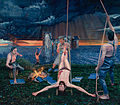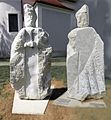Bartholomew (Apostle)

Bartholomew ( Hebrew בר־תלמי Bar-Tôlmay , Aramaic "son of Tholmai") is said to have lived in Cana in Galilee at the beginning of the 1st century .
Biblical tradition
According to the Christian view, Bartholomew was a disciple of Jesus (cf. Mk 3: 14–19 EU ) and one of the twelve apostles , who is named in the apostellists of the first three Gospels . His full name could have been Natanaël Bar-Tolmai , provided that it is to be equated with Natanaël , whose vocation is told in Jn 1,45–50 EU (cf. also Mt 10,3 and a. EU ). It can be assumed that Natanaël Bar-Tolmai was a scribe or scribe student .
Legend (hagiography)
According to legend, he is said to have preached the Hebrew Gospel of Matthew as a "witness of Christ" in India , Mesopotamia and especially in Armenia , where he is also said to have suffered martyrdom . Astyages , a brother of the Armenian ruler Polymios , is said to have given the order to peel off his skin while he was alive and then to crucify him upside down. Other sources report that the saint was beheaded .
According to later legends, the coffin with his body was washed up on the island of Lipari near Sicily , where he was also buried. According to Gregory of Tours , he was brought from Mesopotamia to Lipari in 580. A church was built over his presumed grave, which the Saracens destroyed in 831 .
Church history
Emperor Otto II had the alleged bones brought to Rome in 983 , where they have been kept in San Bartolomeo all'Isola ever since . Bartholomäus then became the patron of many German churches. The alleged brain shell came to the Frankfurt Imperial Cathedral under Emperor Friedrich II. In 1238 , who then received Bartholomew as the church patron.
Iconography and Attributes

Since the beginning of the 13th century, Bartholomew has been shown in numerous pictures with a knife and peeled skin. In Michelangelo's Last Judgment in the Sistine Chapel in Rome, the face on the skin worn by Bartholomew is considered to be Michelangelo's self-portrait.
More recently, there have been new depictions of the apostle, such as the bronze cast by Damien Hirst (2006) or the large-format oil painting by the Leipzig painter Aris Kalaizis , which was created in confrontation with depictions of the saint at the Imperial Cathedral of St. Bartholomew in 2014/2015. In 2015, the Art and Culture Forum Stubenberg erected a Bartholomew sculpture in front of the Stubenberg church . The head is made of marble, the body of magnesite with glittering mica inclusions.
Skinned Saint Bartholomew (statue by Marco d'Agrate in the Milan Cathedral , 1562)
Martyrdom of Saint Bartholomew (painting by Gioacchino Assereto , ca.1630)
Memorial days
- Catholic: August 24th
- Protestant: August 24th
- Anglican: August 24th
- Orthodox: June 11th
Patronage
Patronage
- Places: see Sankt Bartholomä , San Bartolomeo , Saint-Barthélemy , Saint Bartholomew
- For churches and chapels, see Bartholomäuskirche
Bartholomew is the patron saint
- the cities of Baku , Altenburg , Büchenau , Frankfurt am Main , Geraardsbergen , Görwihl , Kettig , Maastricht , Markgröningen , Markranstädt , Pilsen , Wiehe and the Barcola district in Trieste;
- the Aeolian Islands (near Sicily );
- the professions miners , plasterers, farmers , winemakers , shepherds or shepherds , leather workers, tanners , saddlers , shoemakers , tailors , bakers , butchers , bookbinders and oil and cheese traders (in Florence ).
He is said to act as a saint against skin and nervous diseases as well as against convulsions, demons and ghosts.
literature
- Wolfgang Braunfels (ed.): Lexicon of Christian Iconography , Volume 5. Herder, Freiburg 1968 (new edition of the WBG, Darmstadt 2015), columns 320–334. ISBN 978-3-534-26725-5
- Christoph Schmitt: Bartholomäus. In: Biographisch-Bibliographisches Kirchenlexikon (BBKL). Volume 26, Bautz, Nordhausen 2006, ISBN 3-88309-354-8 , Sp. 121-122.
- Otto Wimmer: Handbook of names and saints, with a history of the Christian calendar. 3rd edition Innsbruck / Vienna / Munich 1966, p. 143 f.
- Lexicon for Theology and the Church , Volume II, p. 9 f.
Individual evidence
- ^ Albrecht Dihle : Art. India . In: Reallexikon für Antike und Christianentum , Vol. 18, Anton Hiersemann Verlag, Stuttgart, Sp. 1–56, here Sp. 46.
- ↑ Wolfgang Braunfels (ed.): Lexicon of Christian Iconography , Volume 5. Herder, Freiburg 1968, column 322.
- ↑ Wolfgang Braunfels (ed.): Lexicon of Christian Iconography, Volume 5. Herder, Freiburg 1968, column 322.
- ↑ Saint Bartholomew, Exquisit Pain .
- ↑ Bartholomäus - Ecumenical Lexicon of Saints . Website of the Ecumenical Lexicon of Saints. Retrieved August 24, 2013.
Web links
See also
- Gospel of Bartholomew
- Bartholomew Night (the night of the murder in Paris on August 24, 1572)
| personal data | |
|---|---|
| SURNAME | Bartholomew |
| ALTERNATIVE NAMES | Natanaël Bar-Tolmai |
| BRIEF DESCRIPTION | apostle |
| DATE OF BIRTH | 1st century BC Chr. |
| DATE OF DEATH | 1st century |






